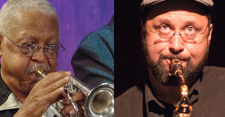BOBBY BRADFORD, HAFEZ MODRIZADEH QUARTET Artists
Cornetist Bobby Bradford's career has zigzagged in a way that has eluded the spotlight. Now 81, he is revered in progressive music circles, yet not as well known as saxophonist and composer Ornette Coleman, a former collaborator, or next-generation saxophonist and composer David Murray, who is the most famous of his many students.Both Bradford and Coleman had moved from Ft. Worth, Texas to Los Angeles and played together early on, but when Bradford was drafted into the Air Force, another great trumpeter, Don Cherry, performed in Coleman’s groundbreaking Quartet. Bradford rejoined Coleman from 1961 to 1963, a period in which they performed infrequently in public (Coleman had tripled his artist fee). Coleman and Bradford did record for Atlantic, but the tapes were among those many destroyed in the Great Atlantic Vault Fire. He is heard, however, on the saxophonist's 1971 Columbia masterpiece, Science Fiction, where his raspy, slurry playing is full of fire. By that point, Bradford had already initiated a long-running partnership with the great clarinetist John Carter, starting with Seeking, an album credited to Carter and Bradford's New Art Jazz Ensemble. They maintained a special partnership until Carter's death in 1991.
Bradford might have more recognition had he, like Coleman, moved from Los Angeles to New York. But he stayed in L.A., raising a family and starting a career at Pomona College, where he taught jazz history and directed the school's jazz ensembles. Just as Horace Tapscott was during his lifetime, Bradford is an important musical and personal mentor for many in greater Los Angeles.
“Those of us who have been blessed to know Bobby Bradford for a number of years can attest to a probing, powerful intellect that assimilates the history of Jazz in a highly unique manner, drawing conclusions that are as innovative and provocative as one of his solos,” writes master flutist James Newton in www.pointofdeparture.org. “His understanding of the history, coupled with his embracing of Jazz’s mandate for innovation, reveals itself in his teaching, playing and composing. I have profoundly admired his brilliant mind, up-tempo wit and his usual location of being two or three steps ahead of everyone else.”
For over two decades, composer/saxophonist/theorist Hafez Modirzadeh has developed his pioneering chromodal concept, a cross-cultural musical approach developed from his own American jazz and Iranian dastgah heritages. He has published extensively on the subject while developing alternative performance techniques to adapt the saxophone to the Persian tuning system. Dr. Modirzadeh studied the dastgah repertoire extensively with Iranian violinist Mahmoud Zoufonoun, followed by a stint at New England Conservatory to study saxophone with Joe Allard and musical concepts with George Russell. He received his Masters from UCLA and his Ph.D. in Ethnomusicology from Wesleyan University. He was twice named an NEA Jazz Fellow (1989, 1991) and was granted a Fulbright to work with Gnawan and Flamenco musicians in Morocco and Andalucia in 2005-06, which resulted in Bemsha Alegria. His three latest releases on Pi Recordings are ground breaking and highly musical. Dr. Modirzadeh is currently a full-time professor of World Culture in Music at San Francisco State University where he directs the World Music and Dance Program.
He has performed internationally over the last 20 years with Don Cherry, Zakir Hussein, Steve Lacy, Oliver Lake, George Lewis, James Newton, Wadada Leo Smith, Omar Sosa, Fred Ho and Miya Masaoka, among others

CONNECT
Hafez Modirzadeh Website









